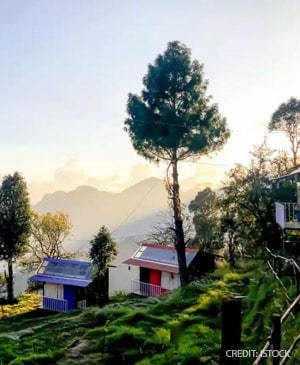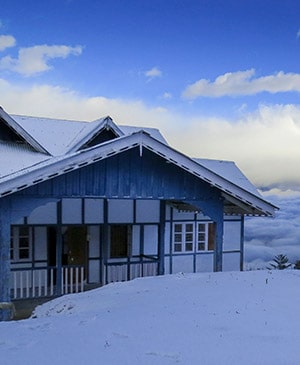Birding in Kashmir and Ladakh
Jammu, Kashmir and Ladakh sit cheek by jowl at the head of India, but the birding experiences they offer are worlds apart.
Kashmir is hailed in India as ‘paradise’ for its incredible scenic beauty. The Great Himalayas tower in the north and east of Kashmir and separate it from the high-altitude Tibetan plateau. The Pir Panjal mountain range envelopes Kashmir from the west and runs along its southern fringe to cut it off from the great plains of India. The geography we thus get is that of a verdant land of fairy-tale valleys, lush forests, glassy lakes and rolling meadows, tucked between the two mountain ranges like a pearl inside an oyster. Birding in Kashmir brings with it the perk of bird-watching in some of the most beautiful birding spots of Western Himalayas.
Now, cut to Ladakh to the east of Kashmir and you would have to suspend disbelief over two places so close being so geographically different. In contrast to the pastoral valleys of Jammu and Kashmir, Ladakh is an arid high-altitude plateau, a desert on the roof of the world, deprived of the famed Indian monsoon by the high peaks of the Himalayas. But what Ladakh loses by way of the rains, it gains by means of the Himalayan snows and glaciers and the river Indus and the many pristine lakes that are home to an exotic variety of avifauna. Birding in Ladakh is a surreal experience of birding in moonscape.
Clubbed together, the birding tours of Kashmir and Ladakh showcase the wonderful birds of the Western Himalayas.
About 674 species of birds have been observed in Jammu, Kashmir and Ladakh, but the checklist keeps expanding and changing every few years. The latest estimates suggest that the count of the bird species of Jammu, Kashmir and Ladakh could be as high as 715, which includes 31 globally threatened species and many exotic birds that draw in thousands of curious birders to North India birding trips every year.
Each region has its own specialties. Orange Bulfinch, Kashmir Nutcracker, Kashmir Nuthatch, Spectacled Finch, Pink-browed Rosefinch and Black-and-yellow Grosbeak are some of the local beauties to chase while on a Kashmir birding tour. Whereas on a Ladakh birding trip, the prize catches are: Black-necked Crane (state bird of Jammu and Kashmir), Long-billed Bush Warbler (rarely sighted and you would be lucky to clap your eyes on one), Bar-headed Goose, Brown-headed Gull, Tibetan Sandgrouse, Tibetan Snowfinch and Mongolian Finch.
A birding trip of Jammu, Kashmir and Ladakh is best approached in phases. You may start either from Ladakh’s capital Leh, or from Kashmir’s heart, Srinagar.
Srinagar is a bustling city, but the area around the Dal Lake throws up sights of Indian Golden Oriole, Eurasian Starling, or a Grey-winged Blackbird, and a stroll into the nearby woods reveals hundreds of Streaked Laughingthrushes, a few Rusty-tailed Flycatchers, fewer Brown-capped Woodpeckers or a rare Kashmir Flycatcher.
The smart thing to do on a Kashmir birdwatching tour is to explore the places farther afield, like Sonmarg, Gulmarg, Padder Valley, Dachigam National Park, Hirpora Wildlife Sanctuary, Hokera Wetland and Wular Lake.
Both Sonmarg and Gulmarg are popular tourist destinations of Kashmir, but the crowd here rarely gets in the way of an intrepid birder. Sonmarg abounds with Spectacled Finches and is known to yield Pink-browed Rosefinch, Himalayan Greenfinches, Eurasian Goldfinches, Rusty-tailed Flycatcher, Asian-brown Flycatcher, Dark-sided Flycatcher, Tytler’s Leaf Warbler, Bar-tailed Treecreeper, and – the best of all – Kashmir Nutcracker and Kashmir Nuthatch.
Gulmarg features many of the aforementioned stunners along with an impressive cast of Monal Pheasant, Koklas Pheasant, Snow Cock, Griffon Vulture, Kashmir Roller, Eurasian Hoopoe, Siberian Stonechat and Rufous-naped Tit.
Padder Valley is a safe bet to see Orange Bulfinch, Rufous Breasted Accentor, and Brown-fronted Woodpecker, while Hokera Wetland hosts as many as 68 varieties of migratory waterfowl species from Siberia, China, Europe and Central Asia.
For an up-close encounter with the wildlife of the Himalayas, we recommend Dachigam National Park, just 22 km off Srinagar, and home to about 150 resident and migratory bird species, such as the bearded vulture Lammergeier, Crimson Tragopan, Himalayan Monal, Red-billed Blue Magpie, Koklas Pheasant, Golden Eagle, Himalayan Rubythroat and a variety of babblers, woodpeckers, redstarts and wagtails.
For more wildlife, one can do worse than head to the Hirpora Wildlife Sanctuary, 70 km to the south of Srinagar and a thriving habitat of around 130 species of birds, including the Western Tragopan, Spotted Forktail, White-capped Redstart, and the handsome Himalayan Woodpecker. And to quench any further thirst for more Jammu and Kashmir birding, you can watch an impressive range of water birds and terrestrial birds at Wular Lake, a Ramsar site and one of the largest freshwater lakes in Asia.
To the east of Kashmir, Ladakh holds out an equally promising birding prospect, but at much higher elevations. Just a drive from Leh to Khardung La, one of the highest motorable passes in the world, reveals the pageantry of Fire-fronted Serin, Guldenstadt’s Redstart, Sulphur-bellied Warbler, White-throated Dipper, Brown Accentor, Tibetan Snowfinch, Robin Accentor and Northern House Martin.
But nothing beats the surreal experience of birding at the remote and pristine Tso Moriri (Lake Moriri), which, at the elevation of 4522 meters, is the highest Ramsar site in the world and one of the largest high-altitude lakes of India. Tso Moriri is the breeding ground for both Black-necked Crane and Bar-headed Goose, and its sapphire blue water, though a touch brackish, attracts birds like Brown-headed Gull, Ferruginous Pochard, Black-necked Grebe, and Great Crested Grebe.
At about the same height are the sparkling Tso Kar (Lake Kar) and its smaller cousin Startsapuk Tso, which are breeding colonies for gulls, grebes and geese. Horned Lark, Red-billed Chough, Mongolian Finch, Tibetan Snowfinch, Great Rosefinch are common here. With a bit of footslog, one may even sight a Tibetan Sandgrouse, Brandt’s Mountain Finch, Mountain Chiffchaff and Blanford’s Snowfinch.
Closer to Leh, the ponds of Shey Marshes along the banks of the Indus make for some interesting birdwatching. Guldenstadt’s Redstarts seem to have a thing for these marshes, given their numbers, and on a good day one may spot the likes of Dark-throated Thrush, Green Sandpiper, Goosander, Water Pipit, Brown Accentors and even a rare Ibisbill or Eurasian Curlew.
Not much farther off, the Hemis National Park is the perfect place to mix Ladakh birding with wildlife, and explore the grounds for the snow leopard (a big attraction in Ladakh), lynx, blue sheep (locally called Bharal), Ladakh Urial and the Tibetan Wild Ass called Kiang. Prominent winged beauties in the park are: White-browed tit-Warbler, Yellow-billed Chough, Himalayan Snowcock, Tibetan Partridge, Ibisbill and Cinerous Tit.
The Ladakh birding tour may stretch all the way to the Nubra and Shyok Valleys in the north and Kargil in the west. Spring, summer and autumn are the best times to do birdwatching in Ladakh and Kashmir.
Having organized many birding trips to Jammu, Kashmir and Ladakh, we at India Birding Tours command the expertise to take you to the places that yield maximum bird sightings. Most of the birding hotspots of Western Himalayas are well within our reach and we understand the specialities of each birding area. So we can chalk out an itinerary depending on your birding wishlist to make sure you get to see and photograph the bird you seek.






